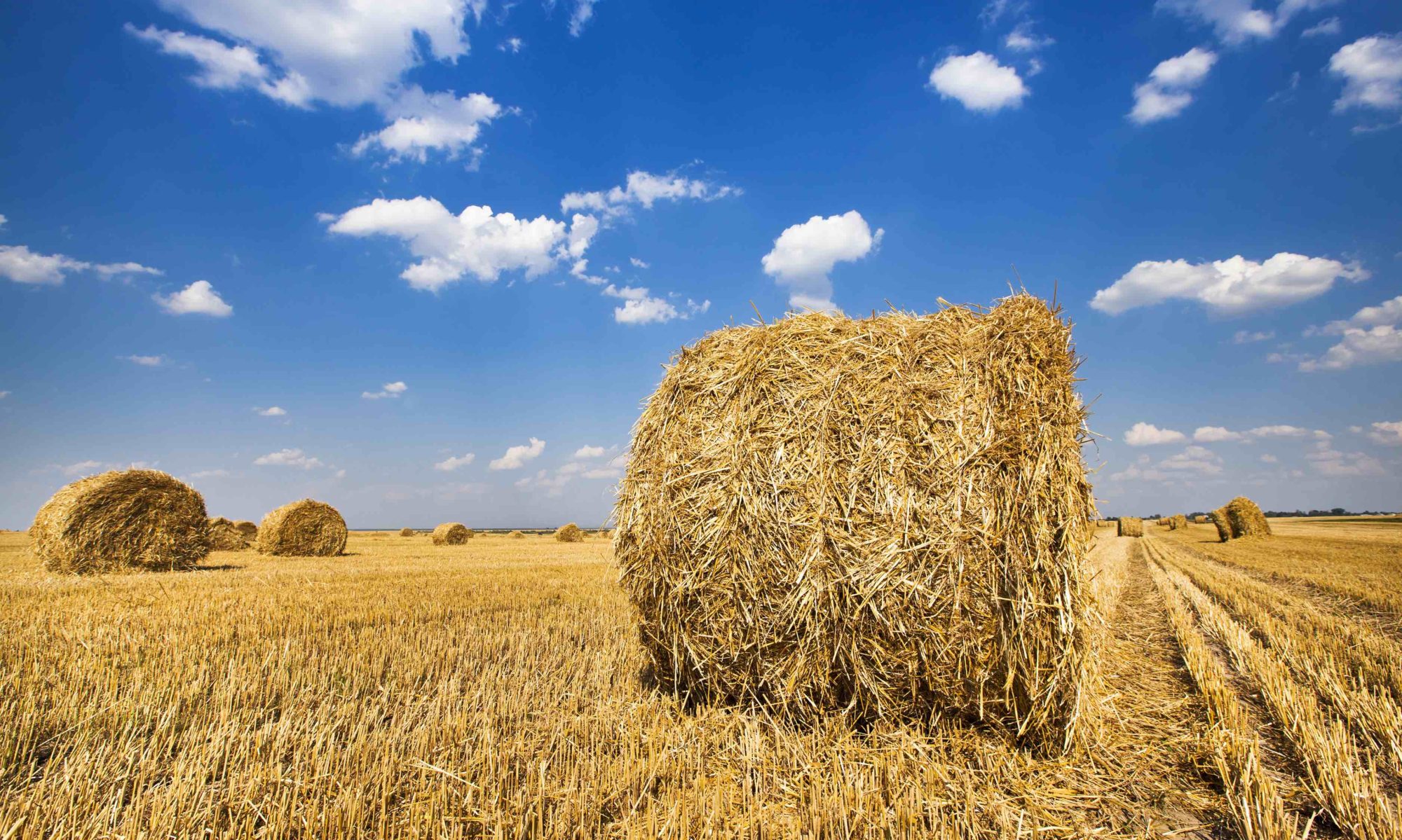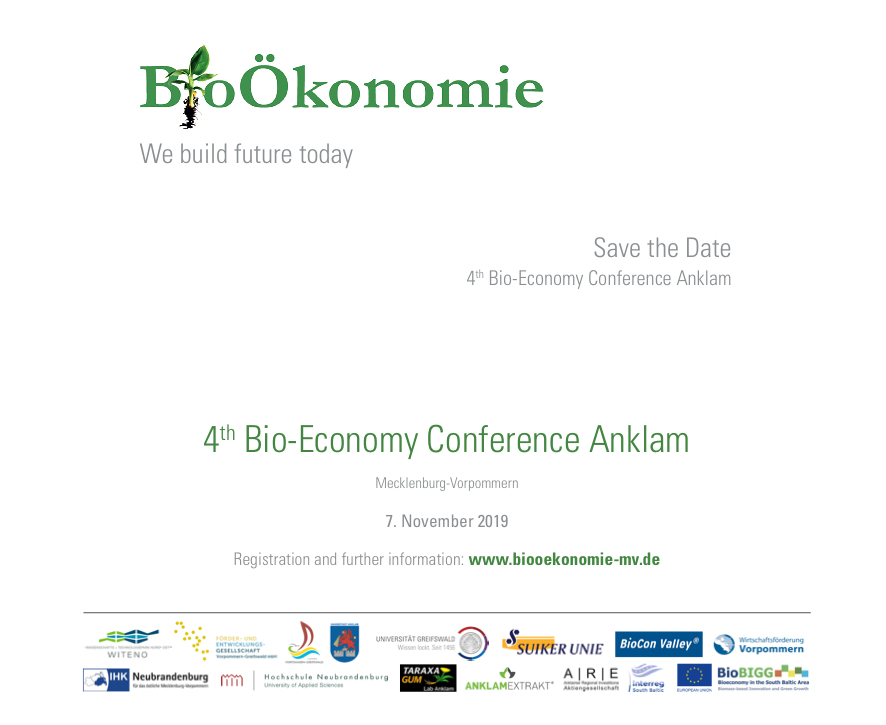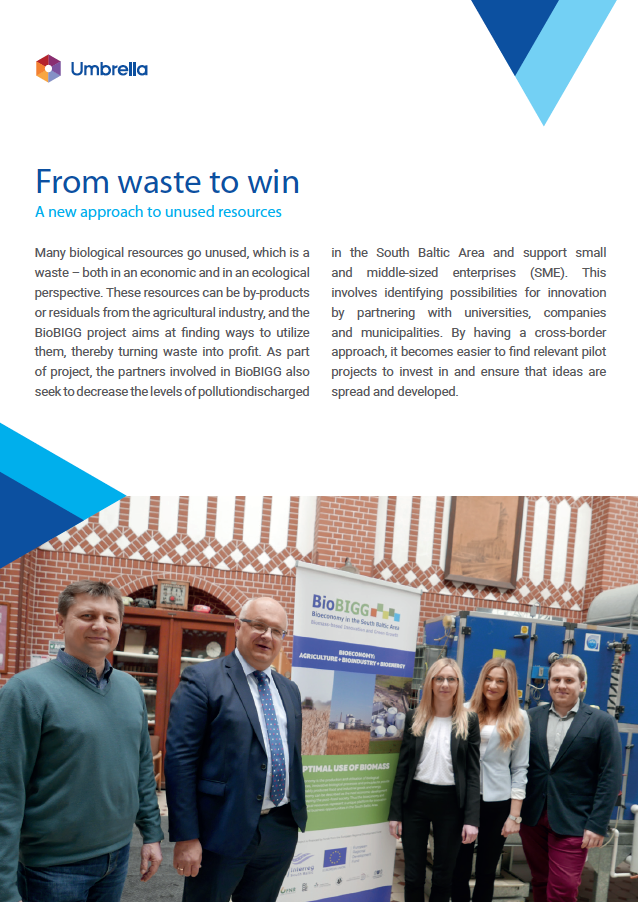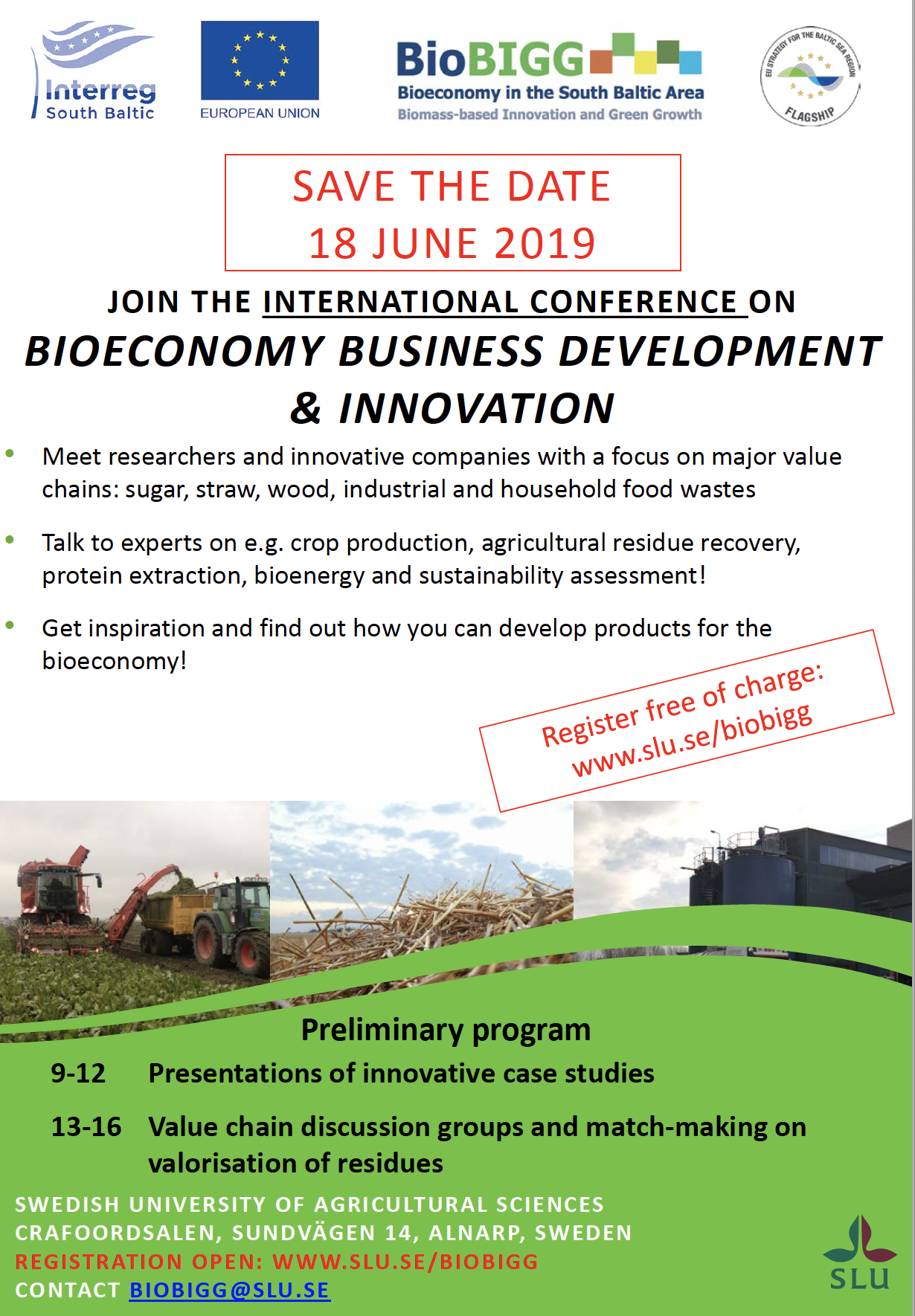BioBIGG International conference on Bioeconomy Business Development & Innovation
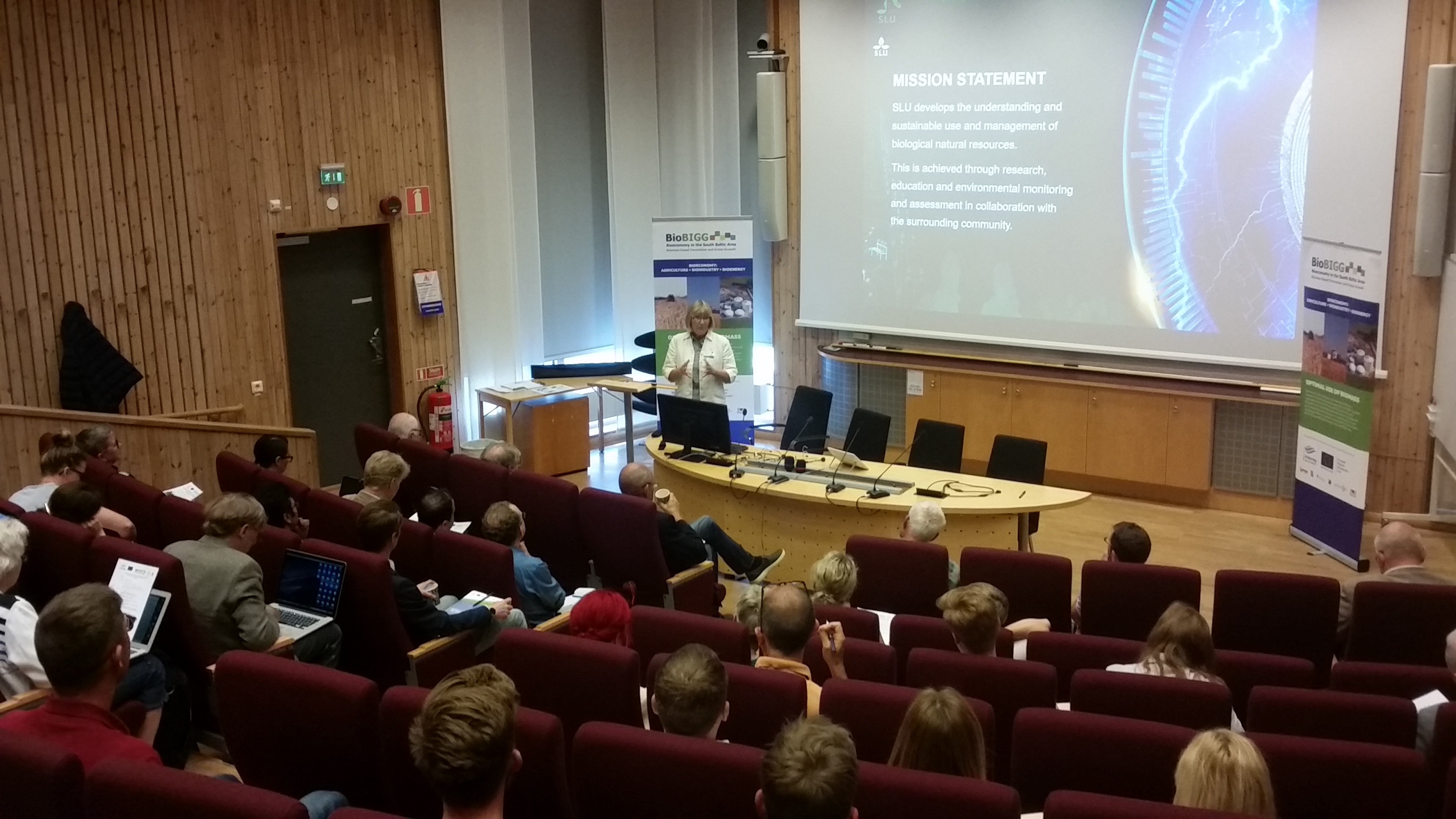
Endless possibilities, many good examples and strong engagement of companies and researchers were demonstrated at the international conference on Bioeconomy Business Development & Innovation that was held recently at the Swedish University of Agricultural Sciences in Alnarp, Sweden
On the 18 June 2019, 47 participants from industry and the research community met in Alnarp, Sweden, to learn more about successful innovations within the bioeconomy and opportunities to be further developed. The Interreg project BioBIGG was the host for this event as part of the project work. Moderated by Bengt Malmberg, RISE, several companies and universities presented their work with making their processes more resource-efficient while at the same time developing new products from side streams that earlier represented a cost as these had to be treated as waste.
Kalle Johansson from Lyckeby Starch, a south Swedish starch producer, underlined the importance on continuous development as they have done in the history of their company. Resource-efficiency and valorization of side streams need to go hand in hand in order to justify the investments in a process addition or change. To see the presentation by Kalle Johansson click on the video below:
As a Polish example, Dariusz Mikielewicz from the University of Gdansk presented Podole Wielkie, a crop and cattle farm, and Farm Frites Poland, a potato factory, formed an intriguing symbiosis, where the companies use each other´s residual streams to close material, energy and nutrient loops.
Paludiculture, or cultivation of rewetted peatlands, was one of the adjusted farming solutions presented by Anke Nordt from the German Mire Centre. The idea originated from the need of decreasing the large greenhouse gas emissions from drained peat soils and suggests potential crop alternatives that result in similar revenue for the involved farmers compared to their original cropping systems – minus a large part of the climate impact.
Using agricultural residues from seed production as solid fuel for biochar production is already a commercial reality in a small town in Skåne, south Sweden. Ann-Mari Fransson from the Swedish University of Agricultural Sciences (SLU) in Alnarp presented the changes that were made in Skånefrö, the seed company, and a number of new opportunities the biochar production has opened up for. Process energy is used for district heating while the biochar is developed as soil improver for urban applications such as city tree plantations, green roofs or innovative stormwater constructions.
Large-scale production of bioplastic polymers is a reality already, with innovative material properties as demonstrated by Åke Rosén from Gaia Biomaterials, Sweden. The feedstock is currently imported from Asia, but could just as well be produced in Sweden, if the full potential of crop production was realised, Åke argued. Furthermore he explained that the right choice of feedstock may also bring additional benefits, such as improved visual material properties and reduced climate impact. To see the presentation by Åke Rosén click on the video below:
As a reaction to the strong trend towards more plant protein based diets, new feedstocks are investigated for the extraction of food grade protein concentrate for direct consumption or as food additive. Thomas Prade and William Newson from the Swedish University of Agricultural Sciences (SLU) presented a prefeasibility study on the use of intermediate crops grown as catch and cover crops as feedstock for this purpose. Within an ongoing innovation project, the Plant Protein Factory, the proposed extraction process with be tested in the soon to be opened pilot plant at SLU. To see the presentation by Thomas Prade and William Newson click on the video below:
Tyge Kjær of the University of Roskilde, Denmark, rounded up the program with remembering the auditorium of the dimensions of the challenge in the transition to a bio-based economy and the still increasing energy and resource demand. On the other hand, the potentials for increased biomass production and supply are large and present a vast variety of opportunities for research and companies to not only solve the environmental problems of today but to create a more sustainable bioeconomy in the near future.
Workshop
In the afternoon, company representatives and researchers gathered for a workshop where barriers and drivers for the development of innovative bio-based products were discussed in thematic sessions. These sessions included the main four value chains that are in the focus of the BioBIGG project and that cover the largest feedstock potentials for product development – straw, forestry residues, industrial and household food wastes and residues from the sugar industry. Common for all value chains was that high potential economic profits for innovative products are in sharp contrast with high investment risk, indicating the need for extended public investment funding. Another barrier was identified in the industry demand for homogeneous feedstocks at constant quality, while residual feedstocks are often varying in quality and volume during the year, boiling it down to issues in storage and logistics.
During the day many ideas were exchanged and developed and horizon widened. The informative atmosphere was appreciated by many participants and the discussions in plenary and breaks were a start to bridge the gap between the researcher´s and the industry´s view on how to promote more and faster product development and residue valorization in the bioeconomy.
BioBIGG collaboration with the Umbrella project
Join the International BioBIGG conference in Alnarp 18th of June
On the 18th of June the BioBIGG project will be hosting an international conference on bioeconomy business development and innovation in Alnarp, Sweden. Here you will be able to get new insights on valorization of biomass-based residues, develop your business and opportunities for cross-border networking. Press here to register.
BIOECONOMY COUNCIL MEETING COPENHAGEN, 9-10th of May
The Nordic Council of Ministers is Policy Area coordinator in the Action Plan for the European Union Strategy for the Baltic Sea Region (EUSBSR) to promote cooperation within the bioeconomy.
The Policy Area (PA) “Bioeconomy” is one of 13 Policy Areas of the EUSBSR Action Plan and covers agriculture, forestry, fisheries and aquaculture as well as rural development. Regular meetings and dialogue activities in the Baltic Sea Region since 2013 have identified key persistent bottlenecks for realising the bioeconomy related to
Bioeconomy Policies, Bio-based Business, R&D and Innovation and Civil Society and Outreach.
Objectives of the meeting in Copenhagen were:
- Creating stronger engagement of participants in council and PA bioeconomy
- Involving participants in trend analysis
- Getting input to revision of action plan
The first day focused on trends of the bioeconomy in the BSR. The second day zoomed on the work carried out in the PA bioeconomy, including the upcoming revision of the EUSBSR Action Plan. Beneath presentations the participants helped to identify key trends within the bioeconomy.
One BioBIGG partner from Germany took part in the meeting to give input on the revision of the action plan. Also the BioBIGG project was introduced to the participants.
Save the day – JOIN THE INTERNATIONAL CONFERENCE ON BIOECONOMY BUSINESS DEVELOPMENT and INNOVATION
Project start of BalticBiomass4Value

The goal of this Interreg programme is to contribute to a more circular bio-economy in the Baltic Sea region. As of January of this year the consortium of BalticBiomass4Value are working towards developing online-based tools, workshops and training concepts for private enterprises and local/ regional authorities, as well as a good practice database for the region. The project’s output will focus on guidelines on circular bioeconomy development, and will promote them through experience exchange and training activities across the region. The first publicly accessible results can be expected in autumn of this year.
For more information and contacts click here
BioBIGG on LinkedIN
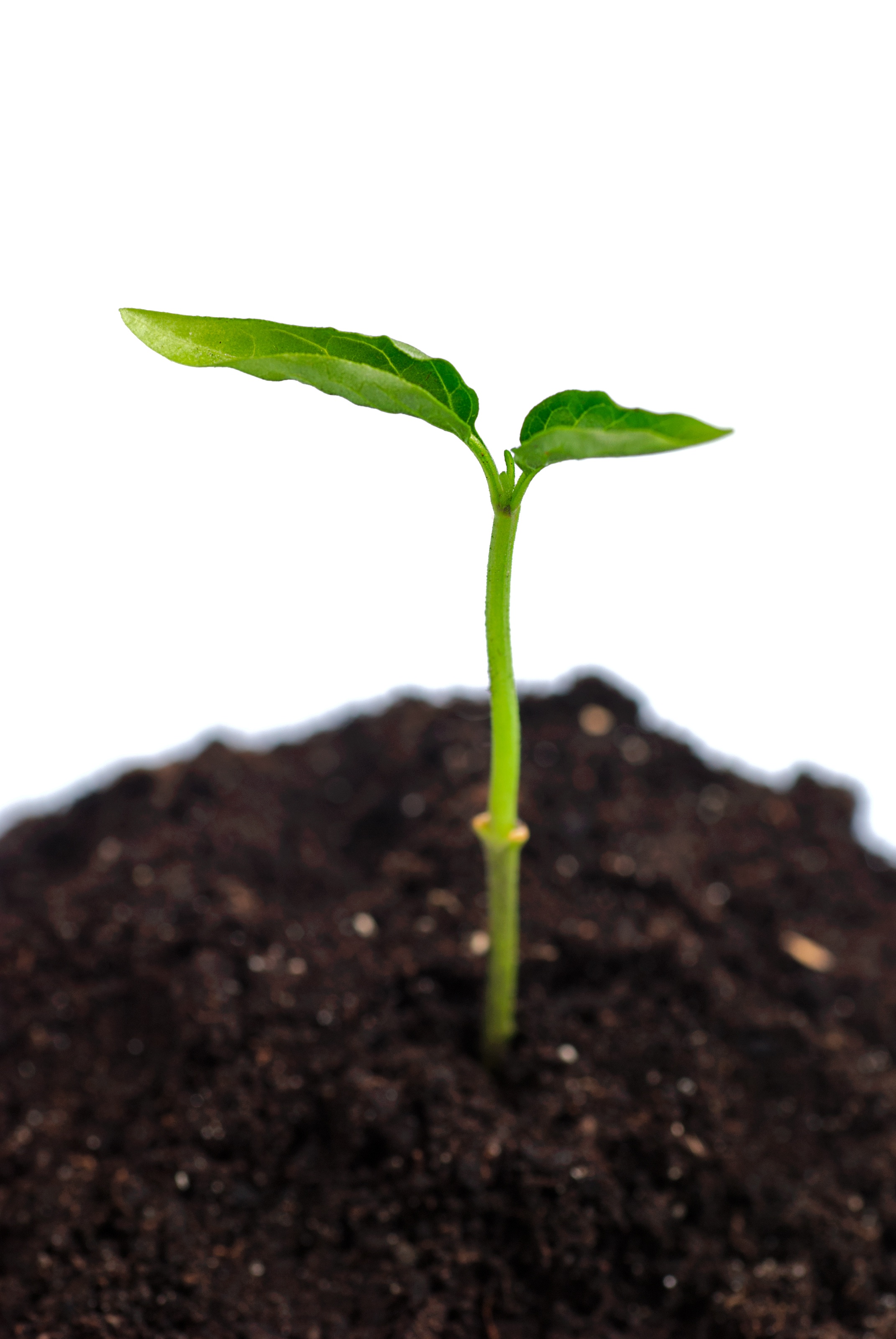
Bioeconomy in the South Baltic area:
This Group will serve as an information hub on bioeconomy in the South Baltic area and beyond. It belongs to the Interreg project BioBIGG, which aims at identifying and developing attractive business opportunities for SMEs within the Bioeconomy and paving the way for a sustainable and circular bioeconomy.
This will be achieved through cross-border knowledge transfer, advisory activities and preparation of specific proposals for production of biomass-based products and services based on regional available biomass, hereby hopefully strengthening the innovation capacity of SMEs and mobilising investments and implementation of technology in the South Baltic area.
The project will host several cross-border events where SMEs and other stakeholders (policy and decision makers and others) can meet to share new insights and solutions for innovative products, processes and business opportunities within the bioeconomy.
BioBIGG project partners:
Roskilde University, RISE (Research Institute of Sweden), Gdańsk University of Technology, University of Greifswald, Swedish University of Agricultural Sciences and Agency for Renewable Resources
BioBIGG Network

You’re interested in news regarding the BioBIGG project and the overall bioeconomy in the South Baltic area – please visit the Linked_In group:
”South Baltic Bioeconomy Network”
Below you find 8 reasons why joining the network is of advantage for you. And if you have any questions – please come forward. It’s possible to ask questions via private message.
8 Benefits of Joining the South Baltic Bioeconomy Network
1. Business development:
Find new ways of connecting to other bioeconomy stakeholders and explore new ideas for future expansion of your core business. During workshops, conferences and other events you will be able to find cooperation partners in the Baltic Area.
2. Knowledge transfer
Learn from the experiences of others who have gone through the same process. The exchange of information will lead to best practice cases and new contacts.
3. Collaborative working:
Networking is about building relationships, which could lead to new and innovativeways of doing business and developing new products. But you are not limited to that. Use our network to implement co-operation within new projects and joint-ventures.
4. Knowledge expansion:
Get access to a shared knowledge base and learn more by being part of a networking group. Information regarding bioeconomy in the Baltic Area is often rare and by being part of a multi-national group of stakeholder you will get insides of other stakeholders and developements in neighboring countries.
5. Market research:
The network gives you a chance to share ideas with other members and possiblepartners, in order to find new markets.
6. Find partners:
Find cooperation partners outside your core business, which complete your expertise by using the contacts provided within the network.
7. Personal development:
Contact and communication to international stakeholder will provide you with the views and state of knowledge of the respective region and institutions. Consequently, this will give you an overview how the regions and institutions define bioeconomy. The differences between the regions will become much clearer.
8. Promoting your company profile:
Get your company noticed. By joining the network your company will be noticed withinthe area by other stakeholders, which might be looking for new partners.
If you are not a member you will never know!
How do we unlock the innovation potential in biomass-based value chains?

On the 6th and 7th of December the BioBIGG project held a two day cross-border workshop in Roskilde, Denmark addressing this question. During the workshop SMEs, universities and local authorities gave presentations on their approach to the implementation of a sustainable and circular bioeconomy with examples of promising utilisation of residues and development of biomass-based value chains.
The Danish SME, DACOFI, was one of the stakeholders that gave a presentation at the workshop. They presented their innovative technology for the filtration of biomass. One of the residues the company has been focusing on is brewers spent grain for the extraction of protein, fibers and vitamins, but the innovative technology has also been successfully applied to potato pulp as well as other types of biomass. Also, Guldborgsund municipality gave a presentation on their approach to developing a sustainable and circular bioeconomy at the local scale.
The second day of the workshop continued with a study tour to the local enterprise Solrød Biogas. Here the participants were first given an introduction to the implementation process – starting from the initial idea to the phase where the biogas plant was taken into operation and innovation efforts since then. Afterwards, participants were given a guided tour of the biogas plant that converts residual products into green energy, and fertiliser that is utilised by nearby farms with benefits for the climate and the environment.

